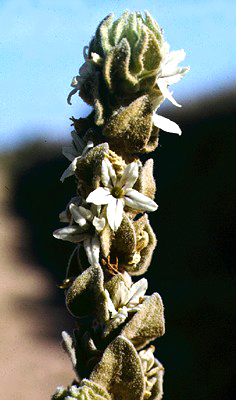
Synonymy
Grammosolen dixonii (F. Muell. & R. Tate) Haegi, Telopea 2: 178 (1981)
Newcastelia dixonii F. Muell. & R. Tate, Trans. & Proc. Roy. Soc. S. Austral. 10: 81 (1888).
T: River Murray, 30 miles from Vic. border, coll. unknown; syn: AD; and Crystal Brook, S.A., S. Dixon s.n.; syn: AD, BM, MEL.
Description
Erect, spreading or sprawling shrub to 2 m high and 5 m diam., greyish. Branches woolly.
Leaves ovate-triangular to subcordate, sessile (or with petiole to 3 mm long), 6–20 mm long, 4–17 mm wide, densely tomentose, entire to undulate.
Inflorescence 1–3–flowered, sometimes forming leafy spikes; pedicels to 0.8 mm long, glabrous. Calyx 3 mm long, densely tomentose. Corolla 7–13 mm long, pubescent outside, papillose inside; lobes 3–8 mm long, 1.5–4 mm wide. Stamens 2.5–5 mm long.
Capsule subglobose, 3.5–4.5 mm long. Seeds 2.5–3.5 mm long.
Distribution and ecology
Occurs in the Murray region, northern Yorke Peninsula and north-eastern Eyre Peninsula, S.A.
Grows in deep sandy soils, often in disturbed mallee-spinifex associations.
Notes
Phylogenetic studies by Garcia & Olmstead (2003) on the Tribe Anthocercideae using two chloroplast DNA regions included this species. The studies indicated that Grammosolen is monophyletic.
Reference: V.F.Garcia & R.G.Olmstead (2003). Phylogenetics of Tribe Anthocercideaea (Solanaceae) based on ndhF and trnL/F sequence data. Systematic Botany 28: 609-615.
A discussion of the tropane alkaloids which occur in Grammosolen and other Anthocercideae can be found in Griffith & Lin (2000). Results showed this genus to be most closely related to nicotine-free species of Cyphanthera.
Ref: W.J. Griffin & G.D. Lin (2000). Chemotaxonomy and geographical distribution of tropane
alkaloids. Phytochemistry 53: 627–628.
Selected specimens
S.A.: 20 km NE of Blanchetown, L. Haegi 676 (AD, BRI, CBG, NSW, NT, PERTH); between Cowell and Arno Bay, D.N. Kraehenbuehl 528 (AD); 13 km WSW of Waikerie, D.E. Symon 8795 (ADW, CANB).
Derivation of epithet
Named for Samuel Dixon, collector of the type specimen, naturalist and early environmentalist in South Australia.
Images and information on web
A fact sheet for this species can be downloaded from the SA eFlora site.




